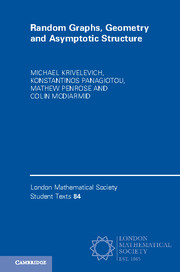
-
Select format
-
- Publisher:
- Cambridge University Press
- Publication date:
- May 2016
- April 2016
- ISBN:
- 9781316479988
- 9781107136571
- 9781316501917
- Dimensions:
- (228 x 152 mm)
- Weight & Pages:
- 0.31kg, 127 Pages
- Dimensions:
- (228 x 152 mm)
- Weight & Pages:
- 2.02kg, 127 Pages
You may already have access via personal or institutional login
Book description
The theory of random graphs is a vital part of the education of any researcher entering the fascinating world of combinatorics. However, due to their diverse nature, the geometric and structural aspects of the theory often remain an obscure part of the formative study of young combinatorialists and probabilists. Moreover, the theory itself, even in its most basic forms, is often considered too advanced to be part of undergraduate curricula, and those who are interested usually learn it mostly through self-study, covering a lot of its fundamentals but little of the more recent developments. This book provides a self-contained and concise introduction to recent developments and techniques for classical problems in the theory of random graphs. Moreover, it covers geometric and topological aspects of the theory and introduces the reader to the diversity and depth of the methods that have been devised in this context.
Reviews
'The chapter on geometric graphs has plenty of exercises … the book will help many novices make their first steps in the field of random graphs.'
Miklós Bóna Source: MAA Reviews (www.maa.org)
Contents
Metrics
Altmetric attention score
Full text views
Full text views help Loading metrics...
Loading metrics...
* Views captured on Cambridge Core between #date#. This data will be updated every 24 hours.
Usage data cannot currently be displayed.
Accessibility standard: Unknown
Why this information is here
This section outlines the accessibility features of this content - including support for screen readers, full keyboard navigation and high-contrast display options. This may not be relevant for you.
Accessibility Information
Accessibility compliance for the PDF of this book is currently unknown and may be updated in the future.


